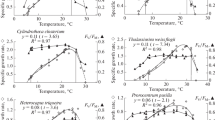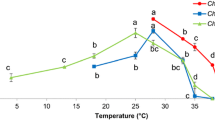Abstract
Thirty-seven species of marine microplanktonic algae from 10 taxonomic classes were tested for their viability in axenic culture after prolonged exposure to darkness at 2°, 10°, and 20°C. The darkness test periods were prolonged in weekly installments up to a maximum of 1 year, and viability retention (survival) was judged from the capability for resuming growth after replacement in light. The 2°C-tests showed 32% of the species reaching the limits of survival with 5–6 months of darkness exposure, but another similar percentage continued to tolerate darkness for double this period. These darkness toleration limits were considerably shorter at 20°C for the strains known to be isolated from cold marine regions, whereas the warm-water strains showed the reverse temperature effect in surviving significantly longer at 10°–20°C than at 2°C. Irrespective of temperature or algal class, the bulk of the more resistant survivors was formed by the strains qualifying as benthic types, about 70% of which tolerated 11–12 months and the rest at least 5–6 months of darkness. A few randomly chosen benthic strains extended this toleration to 3 years of darkness. It was concluded that phytoplankters retain darkness-endurance capacity determined by their ecological origin and with no obvious taxonomic correspondence. The concept of ecological races, characterized by temperature control of darkness survival, is discussed.
Similar content being viewed by others
References
Antia, N. J., and Cheng, J. Y. 1970. The survival of axenic cultures of marine planktonic algae from prolonged exposure to darkness at 20°C.Phycologia 9: 179.
Antia, N. J., Bisalputra, T., Cheng, J. Y., and Kalley, J. P. 1975. Pigment and cytological evidence for reclassification ofNannochloris oculata andMonallantus salina in the Eustigmatophyceae.J. Phycol. 11: 339.
Archibald, P. A., and Teigler, D. J. 1974. Utilization of SEM and freeze-etch techniques in the study of hypnospores.J. Phycol. 10: 9.
Belcher, J. H. 1970. The resistance to desiccation and heat of the asexual cysts of some freshwater Prasinophyceae.Brit. Phycol. J. 5: 173.
Berland, B. R., Bonin, D. J., and Maestrini, S. Y. 1972. Are some bacteria toxic for marine algae?Mar. Biol. 12: 189.
Bunt, J. S., and Lee, C. C. 1972. Data on the composition and dark survival of four sea-ice microalgae.Limnol. Oceanogr. 17: 458.
Carpenter, E. J., and Guillard, R. R. L. 1971. Intraspecific differences in nitrate half-saturation constants for three species of marine phytoplankton.Ecology 52: 183.
Fournier, R. O. 1970. Studies on pigmented microorganisms from aphotic marine environments.Limnol. Oceanogr. 15: 675.
Green, J. C. 1975. The fine-structure and taxonomy of the haptophycean flagellatePavlova lutheri (Droop) comb. nov. (=Monochrysis lutheri Droop).J. Mar. Biol. Assoc. U.K. 55: 785.
Guillard, R. R. L., and Ryther, J. H. 1962. Studies of marine planktonic diatoms I.Cyclotella nana Hustedt, andDetonula confervacea (Cleve) Gran.Can. J. Microbiol. 8: 229.
Guillard, R. R. L., Carpenter, E. J., and Reimann, B. E. F. 1974.Skeletonema menzelii sp. nov., a new diatom from the western Atlantic Ocean.Phycologia 13: 131.
Hamilton, R. D., Holm-Hansen, O., and Strickland, J. D. H. 1968. Notes on the occurrence of living microscopic organisms in deep water.Deep-Sea Res. 15: 651.
Hargraves, P. E., and Guillard, R. R. L. 1974. Structural and physiological observations on some small marine diatoms.Phycologia 13: 163.
Hendey, N. I. 1964. An Introductory Account of the Smaller Algae of British Coastal Waters. Part V: Bacillariophyceae (Diatoms). Fishery Investigations Series IV of U.K. Ministry of Agriculture, Fisheries and Food. London: Her Majesty's Stationary Office, London.
Horner, R., and Alexander, V. 1972. Algal populations in-Arctic sea ice: An investigation of heterotrophy.Limnol. Oceanogr. 17: 454.
Hulburt, E. M., and Guillard, R. R. L. 1968. The relationship of the distribution of the diatomSkeletonema tropicum to temperature.Ecology 49: 337.
Jitts, H. R., McAllister, C. D., Stephens, K., and Strickland, J. D. H. 1964. The cell division rates of some marine phytoplankters as a function of light and temperature.J. Fish. Res. Board Can. 21: 139.
Malone, T. C., Garside, C., Anderson, R., and Roels, O. A. 1973. The possible occurrence of photosynthetic microorganisms in deep-sea sediments of the North Atlantic.J. Phycol. 9: 482.
Parke, M. 1949. Studies on marine flagellates.J. Mar. Biol. Assoc. U.K. 28: 255.
Round, F. E. 1971. Benthic marine diatoms.Oceanogr. Mar. Biol. Ann. Rev. 9: 83.
Smayda, T. J., and Mitchell-Innes, B. 1974. Dark survival of autotrophic planktonic marine diatoms.Marine Biol. 25: 195.
Stanier, R. Y., Kunisawa, R., Mandell, M., and Cohen-Bazire, G. 1971. Properties and purification of unicellular blue-green algae (Order Chroococcales).Bacteriol. Rev. 35: 171.
Umebayashi, O. 1972. Preservation of some cultured diatoms.Bull. Tokai Regional Fish. Res. Lab. 69: 55.
Wall, D., Guillard, R. R. L., Dale, B., Swift, E., and Watabe, N. 1970. Calcitic resting cysts inPeridinium trochoideum (Stein) Lemmermann, an autotrophic marine dinoflagellate.Phycologia 9: 151.
Author information
Authors and Affiliations
Additional information
The termdarkness-survival is used throughout this report to denote the retention of cellular viability by an algawithout growth (i.e., without significant increase in cellular mass or numbers) during exposure to darkness. Implicit in this definition is the denial of any known possibility of growth, either autotrophic requiring light or heterotrophic requiring organic-carbon, since both these agents are effectively absent in the survival cases considered here.
Rights and permissions
About this article
Cite this article
Antia, N.J. Effects of temperature on the darkness survival of marine microplanktonic algae. Microb Ecol 3, 41–54 (1976). https://doi.org/10.1007/BF02011452
Issue Date:
DOI: https://doi.org/10.1007/BF02011452




